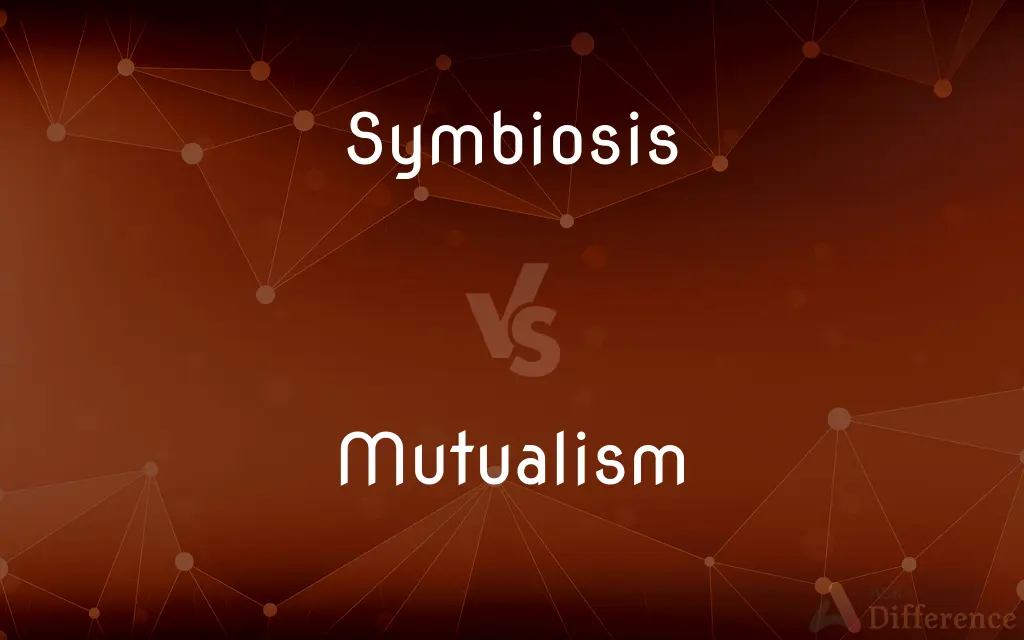Symbiosis vs. Mutualism — What's the Difference?
Edited by Tayyaba Rehman — By Fiza Rafique — Updated on September 22, 2023
Symbiosis refers to a close and long-term biological interaction between different species. Mutualism is a specific type of symbiosis where both organisms benefit.

Difference Between Symbiosis and Mutualism
Table of Contents
ADVERTISEMENT
Key Differences
Symbiosis is a general term that refers to the close, long-term interaction between two or more different biological species. Mutualism is a subtype of symbiosis where both organisms involved derive some form of benefit from the interaction. Mutualism is therefore a more specific form of symbiosis, focusing only on positive interactions.
Symbiosis encompasses various types of relationships, not all of which are mutually beneficial. It could involve parasitism, where one organism benefits at the other's expense, or commensalism, where one organism benefits while the other is neither helped nor harmed. Mutualism, on the other hand, strictly involves situations where both organisms benefit.
While symbiosis can occur in a wide range of biological settings, including between plants, animals, and microorganisms, mutualism usually refers to more specific interactions where the benefits are often immediate and direct. Both symbiosis and mutualism are widely studied in ecology, but mutualism has a narrower focus within that field.
Symbiosis is a term that you might encounter in various scientific disciplines, including but not limited to, biology, ecology, and environmental science. Mutualism, however, is more likely to be discussed in ecological contexts where cooperative interactions between species are being specifically studied.
Symbiosis can be obligate, where the relationship is essential for the survival of at least one organism, or facultative, where it is beneficial but not essential. Mutualism often tends to be obligate because both organisms are usually highly dependent on the interaction for survival or for obtaining a specific benefit.
ADVERTISEMENT
Comparison Chart
Specificity
General term
Specific subtype
Benefit to Organisms
May or may not be mutual
Always mutual
Fields of Study
Biology, Ecology, etc.
Mainly Ecology
Types
Includes mutualism, commensalism, parasitism
Strictly positive interaction
Dependency
Can be obligate or facultative
Often obligate
Compare with Definitions
Symbiosis
Can be mutualistic, parasitic, or commensal.
The symbiosis between a shark and remora is often considered commensal.
Mutualism
Specific type of symbiosis.
Mutualism exists between pollinators and plants.
Symbiosis
Long-term relationship in nature.
Symbiosis is crucial for balanced ecosystems.
Mutualism
Often obligate interactions.
Cleaner fish and their hosts engage in mutualism.
Symbiosis
Biological interaction between different species.
The symbiosis between bees and flowers benefits both.
Mutualism
Both parties benefit.
In mutualism, neither species suffers.
Symbiosis
Interdependence in nature.
Symbiosis often results in a balanced relationship.
Mutualism
Positive biological interaction.
Mutualism contributes to ecosystem balance.
Symbiosis
Coexistence of organisms.
Symbiosis can be observed in many habitats.
Mutualism
Cooperative relationship.
Mutualism enhances survival chances.
Symbiosis
Symbiosis (from Greek συμβίωσις, symbíōsis, "living together", from σύν, sýn, "together", and βίωσις, bíōsis, "living") is any type of a close and long-term biological interaction between two different biological organisms, be it mutualistic, commensalistic, or parasitic. The organisms, each termed a symbiont, must be of different species.
Mutualism
An association between two organisms of different species in which each member benefits.
Symbiosis
(Biology) A close, prolonged association between two or more different organisms of different species that may, but does not necessarily, benefit each member.
Mutualism
(ecology) Any interaction between two species that benefits both; typically involves the exchange of substances or services.
Symbiosis
A relationship of mutual benefit or dependence.
Mutualism
An economic theory and anarchist school of thought that advocates a society where each person might possess a means of production, either individually or collectively, with trade representing equivalent amounts of labor in the free market.
Symbiosis
A relationship of mutual benefit, especially among different species.
Mutualism
The doctrine of mutual dependence as the condition of individual and social welfare.
Symbiosis
(ecology) A close, prolonged association between two or more organisms of different species that normally benefits both members. An interspecies cooperation.
Mutualism
The relation between two different species of organisms that are interdependent; each gains benefits from the other
Symbiosis
(biology) A close, prolonged association between two or more organisms of different species, regardless of benefit to the members.
Symbiosis
The state of people of different types, races, cultures, communities, etc., living together.
Symbiosis
The occurrence of two different or opposing things in the same time and place.
Symbiosis
The living together in more or less imitative association or even close union of two dissimilar organisms. In a broad sense the term includes parasitism, or antagonistic symbiosis or antipathetic symbiosis, in which the association is disadvantageous or destructive to one of the organisms, but ordinarily it is used of cases where the association is advantageous, or often necessary, to one or both, and not harmful to either. When there is bodily union (in extreme cases so close that the two form practically a single body, as in the union of algæ and fungi to form lichens, and in the inclusion of algæ in radiolarians) it is called conjunctive symbiosis; if there is no actual union of the organisms (as in the association of ants with myrmecophytes), disjunctive symbiosis.
Symbiosis
The relation between two different species of organisms that are interdependent; each gains benefits from the other
Common Curiosities
Is mutualism common in nature?
Yes, mutualism is quite common and can be found in various ecosystems.
Does mutualism require physical contact?
Not always; sometimes the relationship is more indirect.
Is symbiosis always beneficial?
No, symbiosis can be mutualistic, commensal, or parasitic.
Can symbiosis be temporary?
Symbiosis is generally considered a long-term interaction.
Is mutualism a type of symbiosis?
Yes, mutualism is a specific type of symbiosis where both organisms benefit.
Is symbiosis a broader term than mutualism?
Yes, symbiosis is broader and encompasses various types of relationships.
Can symbiosis exist between plants and animals?
Yes, symbiosis can occur between different kinds of organisms, including plants and animals.
Does symbiosis involve more than two species?
Generally, it involves two species, but more complex interactions can occur.
Can mutualism evolve into another form of symbiosis?
It's possible, although generally, these relationships are stable.
Is mutualism always long-term?
Generally, yes, as it often involves significant dependency.
Are there artificial forms of symbiosis?
While most are natural, some forms can be artificially created.
Can mutualism occur between individuals of the same species?
Typically, mutualism involves individuals from different species.
Does mutualism impact ecosystem balance?
Yes, it can significantly contribute to ecosystem health.
Is symbiosis studied in human biology?
It is mainly studied in ecology but has relevance in human biology, such as gut flora.
Is symbiosis the same as cooperation?
No, cooperation is a broader term and can occur within the same species.
Share Your Discovery

Previous Comparison
Canal vs. Stream
Next Comparison
Coupling vs. CohesionAuthor Spotlight
Written by
Fiza RafiqueFiza Rafique is a skilled content writer at AskDifference.com, where she meticulously refines and enhances written pieces. Drawing from her vast editorial expertise, Fiza ensures clarity, accuracy, and precision in every article. Passionate about language, she continually seeks to elevate the quality of content for readers worldwide.
Edited by
Tayyaba RehmanTayyaba Rehman is a distinguished writer, currently serving as a primary contributor to askdifference.com. As a researcher in semantics and etymology, Tayyaba's passion for the complexity of languages and their distinctions has found a perfect home on the platform. Tayyaba delves into the intricacies of language, distinguishing between commonly confused words and phrases, thereby providing clarity for readers worldwide.














































